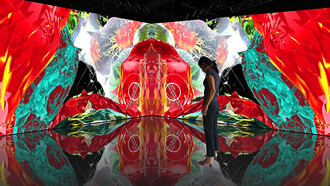Different from artistic works that take place in institutionalized spaces (museums, galleries, theaters), those carried out on the streets and in public spaces are considered Urban Art (Street Art).
Urban art is expressed through music, theater, circus, drawing, etc. There are countless performances on city streets, where, fundamentally, artists seek to be paid by those who stop and watch their performances. In this case, the art exercised in the streets is their bread and butter. For graffiti, it is different.
Graffiti artists are different from vandals. All over the world, countless graffiti artists have been writing, drawing, and painting on walls since antiquity (cave paintings). They are the subject of many controversies regarding the recognition and legality of their work. Some assume their identities, others camouflage themselves in pseudonyms, many go unnoticed, and others become famous. The latter include, for example Basquiat, Os Gêmeos from São Paulo, and the super creative Banksy, pseudonym of the guerrilla artist who had one of his panels covered in paint by municipal employees of the British city of Bristol, and subsequently had all his works preserved by the City Council of the same city. Graffiti works are always being condemned and protected, generating controversies among municipal regulatory systems everywhere.
The context of the streets - more specifically its walls – is the canvas and the frame chosen by graffiti artists. Graffitiing consists of expressing in drawings, in sentences, what one feels and perceives in everyday life, especially in relation to the urban experience. It shows people in different ways, oneiric forms, peculiar perceptions.
Graffitiing is screaming, expressing how one feels. These screams - these expressions - sum up individual weak and unexposed cries. There lies the motivation, the subtlety and the popularity of graffiti: it exposes murmurs with screams for the whole city to hear.
The important thing in graffiti is graffitiing what happens in the form of drawings and/or words, establishing summaries that open up like dynamites, explosions that clarify what happens in the streets, in the houses, in the heads. In this sense, graffiti replaces cartoons in newspapers, as much as it sums up comic strips of superheroes. It is the animated comic strip, the hidden confessions of public restrooms. There is always an aspect of an individual explosion in face of what imprisons. Graffiti can also be an expression of revolt, of criticism to the alienating system. It is libertarian as long as it expresses feelings. Everything in a graffiti work is an act against an established situation, the manifestation of a desire, a consideration, a criticism. Thus, graffiti stands as an urban protest.
Unfortunately, we are in a system in which everything is capitalized, used, imitated. Since graffiti became popular in modern cities, people, companies, organizations, and even religious institutions started making propaganda, warnings, verses, and sacred designs using graffiti to attract customers and consumers, or to fish for souls.
This spontaneous art, this cry of the people, coagulated and expressed on the walls - graffiti - is also transformed by the mediation of dealers (gallery owners and agents) into a luxury object, an expensive painting. Then we have the streets on the walls, decorating immense livings. In this way, graffiti becomes fashionable and begins to have added value; its screams are thus mechanized either by enlargement or by gagging.















